Abstract
As fossil fuels continue to be extracted and used, issues such as environmental pollution and energy scarcity are surfacing. For the transportation industry, the best way to achieve the goal of “carbon neutrality” is to research efficient power systems and develop new alternative fuels. As the world’s largest product of chemicals, ammonia is a new renewable fuel with good combustion energy. It can be used as an alternative fuel to reduce carbon emissions because of its proven production process, low production and transportation costs, safe storage, the absence of carbon-containing compounds in its emissions, and its future recyclability. This paper firstly introduces the characteristics of ammonia fuel engine and its problems; then it summarizes the effects of various ammonia-blended fuels on the combustion and emission characteristics of the engine from the combustion problem of ammonia-blended engine; then the fuel storage of ammonia-blended hydrogen is discussed, the feasibility of hydrogen production instead of hydrogen storage is introduced.
1. Introduction
The overexploitation of fossil fuels has been a global hot topic in recent years, and the emissions from their use have caused pollution in the environment. The environmental problems caused by the use of fossil fuels have also been subject to social controversy [1].
According to IEA (International Energy Agency) statistics, the top five countries in the world in terms of carbon emissions from 2000–2019 are China, the United States, India, Russia, Japan. The combustion and use of fossil fuels remains a major part of overall carbon emissions. As of 2019, the transportation sector sits in second place in terms of total emissions share, accounting for 24% of total emissions [2,3,4,5]. According to the IPCC (Intergovernmental Panel on Climate Change), human activities have led to a global temperature increase of 1.0 °C since industrialization by 2018, and it is expected that global warming could reach 1.5 °C by 2030–2052 at this rate [3].
For human societies, the impacts of climate change caused by carbon emissions are serious, and many of the impacts that have already occurred may be irreversible (e.g., carbon emissions are one of the main causes of global temperature increases). Based on this understanding, at the international level, the Paris Agreement was released in 2015, requiring countries and sectors around the world to set a long-term goal of keeping the global average temperature within 2 °C of the industrialization period and within 1.5 °C as much as possible, which sets the tone for reducing carbon emissions at the international level. In September 2020, China also proposed two goals of “carbon peaking” and “carbon neutrality” at the 75th session of the United Nations General Assembly, setting the development strategy for reducing carbon emissions in China. Since then, according to the UK Energy and Climate Think Tank, as of January 2021, 14 countries have proposed achieving carbon neutrality in strategy documents and six countries in legal documents [2].
Reducing carbon emissions and achieving “carbon neutrality” are mainly divided into four categories: Carbon substitution, carbon emission reduction, carbon sequestration and carbon recycling. Among them, the transportation industry mainly achieves carbon neutrality through carbon emission reduction measures. For the transportation industry, carbon reduction is usually achieved by increasing the proportion of electric vehicles, developing fuel cell power systems, improving power efficiency, and studying biomass substitution to reduce the content of “black carbon” in “carbon neutrality” (“black carbon” refers to the carbon content of emissions that cannot be recycled), thereby reducing carbon emissions [2].
In the field of electric vehicles, as of 2017, first in the global share of new energy vehicles is China, but its proportion of electric vehicles only reached 2.7% (see Figure 1); as an example, we can find that trying to reduce carbon emissions by increasing the share of electric vehicles globally is still difficult to achieve in the short term. In addition, as of 2017, the highest share of global electricity sources is still fossil fuel/nuclear, making up 73.5%. Renewable energy, on the other hand, accounts for only 26.5%, in contrast to 2010, when the global share of renewable energy was only 19.4%. While the annual growth ratio of renewables is slowly increasing, the current base of non-clean energy sources is large and the use of electricity will still be considered environmentally unfriendly in the short term.
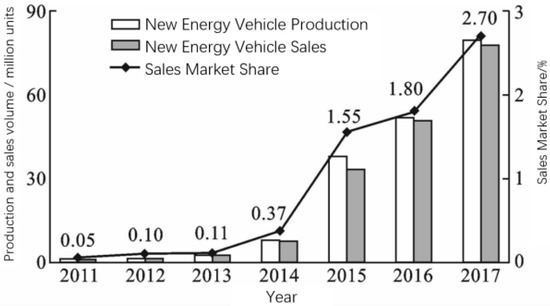
Figure 1.
China’s new energy vehicle production and sales from 2011 to 2017.
Therefore, researching more efficient power systems, developing effective alternative fuels, and realizing the effective use of low-carbon renewable energy can be extremely effective in reducing the carbon emissions of our transportation industry.
There are many alternative fuels for internal combustion engines that have been studied, such as ammonia, hydrogen, biodiesel, alcohols, liquefied petroleum gas, etc. [6,7]. Among them, hydrogen has been widely considered to be one of the most desirable ones. It has high combustion efficiency and the only final product of complete combustion is water; moreover, hydrogen can be produced by many methods, such as water–oil–gas biofuel sewage sludge, etc. [8] So hydrogen is an ideal, renewable, clean energy source with no pollutant emissions [9]. In contrast, there are many challenges in the promotion of hydrogen, such as the great difficulty in liquefaction and the low energy density in volume. Thus, the high cost of hydrogen storage and transportation, and the high operating cost also limit the promotion of hydrogen refueling stations; meanwhile, the wide ignition range and low ignition energy of hydrogen will lead to backfire and early combustion in the process of engine combustion [10,11].
Since many similar technical challenges have not yet been overcome, hydrogen has not been promoted and developed as a backup fuel for internal combustion engines. However, in the field of fuel cells, hydrogen fuel cells have good benefits and are widely promoted.
Like hydrogen, ammonia is an excellent renewable energy with great promise. The complete combustion product of ammonia is extremely clean, only water and nitrogen; and as the second largest industrial synthesis, the production process of ammonia is already quite mature, and there are sufficient sources of ammonia all over the country. Today, a widely used method of ammonia synthesis is the Haber–Bosch method, which synthesizes ammonia from hydrogen and nitrogen. In addition, researchers worldwide are currently working on a non-polluting method of hydrogen synthesis (i.e., a “green hydrogen” production method) [12], which also reduces the carbon emissions of ammonia in its production.
This paper firstly introduces the characteristics of ammonia-fueled engines and their problems; from the combustion problems of ammonia-blended engines, it introduces the difficulties of early and recent ammonia-fueled engines and emphasizes the importance of ammonia-blended engine research; it summarizes the effects of various ammonia-blended fuels on the combustion and emission characteristics of engines and analyzes the superiority of ammonia-blended hydrogen-fueled engines; then it discusses The optimal blending ratio of ammonia-blended hydrogen and fuel storage are discussed, and the advantages and disadvantages of hydrogen production instead of hydrogen storage are pointed out. There is further development of ammonia-doped hydrogen engines.
2. Ammonia Fuel Engine’s Characteristics and Problems
2.1. Physical and Chemical Properties of Ammonia
At room temperature, ammonia is a colorless, water-soluble, irritating odor, and corrosive gas [13]. When used as a fuel, ammonia has a high calorific value, high octane number and good combustion efficiency, as shown in Table 1 [14,15]; moreover, ammonia is a zero-carbon fuel and its complete combustion products are only N2 and H2 (as shown in the formula), without any emission of carbon-containing compounds at all [16].

Table 1.
Physicochemical properties of different fuels.
In addition, ammonia is an important chemical feedstock in the world, its production process is well developed [17], and the corresponding production cost is very low, and there are sufficient sources of ammonia in all regions of the world; as a fuel, ammonia is significantly less difficult to liquefy (−33 °C or 9 bar at room temperature) compared with hydrogen (atmospheric pressure −253 °C) and natural gas (atmospheric pressure −163 °C) [18,19,20], thus the storage costs of ammonia are low, and it is suitable for promotion in various fields.
2.2. Advantages of Ammonia as a Fuel
As shown in Table 1 [14,15], ammonia has a higher energy density than hydrogen and natural gas, which are also used for liquid transportation, so when it is used as a fuel, the same volume of fuel tank can support a higher mileage or a smaller tank size for the same mileage; secondly, since ammonia has a higher octane number than fossil fuels, it can also increase the compression ratio of the engine to obtain a higher cycle thermal efficiency [21]; Liu et al. found through experiments [22] that using ammonia as fuel can usually increase the cycle thermal efficiency of an engine to more than 50%, compared with only 30% to 37% for an ordinary engine; moreover, because of the low difficulty of ammonia liquefaction, ammonia storage can be achieved with ordinary hydraulic cylinders without using more costly storage tools and transportation networks.
2.3. Problems with Ammonia-Fueled Engines
Relatively, ammonia is toxic and corrosive, and poses a risk when inhaled [23,24], although it is easily detectable at low concentrations (0.6–53 ppm) due to its irritating odor [25,26,27]. Secondly, during actual combustion, ammonia has a slow combustion rate and is prone to incomplete combustion, which leads to ammonia escape with the emission of large amounts of NOx (nitrogen oxides), causing more serious environmental damage (compared to CO2 emissions). Furthermore, ammonia has a high minimum ignition energy and low calorific value, which makes it difficult to ignite it directly in the engine.
To address the difficulties and challenges of ammonia as a fuel, many researchers have conducted a number of investigations and experiments on ammonia as a fuel, some of the results of which are more positive:
- While ammonia is corrosive, it has been found through tests that it causes minimal effect on the metal materials (cast iron, steel) currently used in engines [20,22];
- It has also been found in some tests that the combustion of ammonia as a fuel or mixed with other fuels leads to an increase in NOx emissions in the exhaust gas. However, the widely used SCR technology in automobiles treats and cleans up to 90% of the emitted NOx, which can mitigate the possible deterioration of emissions caused by ammonia fuel [13,28,29];
- Ammonia as a fuel often results in the presence of ammonia escape from the engine due to incomplete combustion. However, it was found experimentally that this phenomenon was mitigated to some extent after the installation of ammonia treatment devices;
- For the poor combustion performance of ammonia, ammonia-blending engine research has been widely carried out in the world; it can be blended by using other fuels as combustion aids to effectively improve the ammonia combustion phenomenon [30].
In conclusion, while ammonia still has many shortcomings as an alternative fuel, many researchers have nevertheless discovered through testing the appropriate countermeasures that can correct it to an acceptable range. This means that ammonia is feasible as an alternative fuel.
3. Pure Ammonia Fueled Engines
The use of ammonia as a fuel dates back to 1878, which was the first time ammonia was proposed as a power source [31]. Since then, due to the poor combustion performance of ammonia, subsequent research on ammonia fuel has been conducted mainly by the U.S. military to overcome the limitations of the fuel to fossil fuels [32]. However, due to the poor combustion properties of ammonia, fewer attempts have been made by researchers in the field of compression-ignition engines, and the combustion of ammonia fuels could only be achieved at a compression ratio of 35:1 and an inlet gas temperature above 423k by Gray et al. [33]. Pearsall et al. tried to perform experiments on compression-ignition engines at a compression ratio of 30:1, but were unable to achieve ignition of ammonia fuel [34,35].
Because of the poor combustion performance of ammonia fuels, Pearsall et al. instead attempted to convert a spark-ignition engine into an ammonia-fueled engine. They modified a spark-ignition engine to investigate the effects of pure ammonia fuel on fuel consumption rate and peak engine ignition pressure at 1800 rpm at compression ratios of 12:1, 16:1, and 18:1. The results showed that at a high compression ratio of 18:1, the peak ignition pressure of pure ammonia fuel would increase by 100 psi compared to that at 16:1, although the fuel consumption rate did not change much, but the fuel consumption rate of the engine at 12:1 compression ratio increased by 6%; however, the sspark plugs of the engine were all significantly damaged while running at 18:1 compression ratio [34,35].
Li et al. conducted a combustion study of ammonia under oxygen-enriched conditions to observe the improvement effect of different oxygen levels on ammonia combustion. Their experiments on ammonia combustion were conducted at oxygen concentrations ranging from 21% to 30%, and it was found that the combustion properties of ammonia were significantly improved in an oxygen-enriched environment, and the maximum combustion rate of ammonia was 38.6 cm/s when the oxygen content reached 30%, which was about 2.6 times higher than that at an oxygen content of 21%. In the emission field, the combustion of ammonia under oxygen-enriched conditions would tend to produce more NO2 rather than NO [36].
Due to the poor combustion performance of ammonia and the fact that the cost of ammonia was not addressed in early research [34], the study of ammonia as a fuel was only a military alternative to prevent the plight of fossil fuel shortage rather than used as a reliable fuel, and thus was not widely promoted and studied. In recent years, with global warming and other environmental issues, ammonia fuels have received renewed attention from society and the scientific community as a potential carbon-free and recyclable energy source. Still, the poor combustion performance of pure ammonia fuels remains unresolved, while the combustion performance of ammonia fuels is significantly improved when they are blended [37], so people in various fields have gradually started to turn to the study of ammonia-blended engines.
4. Common Ammonia-Blended Fuel
As described in Section 2.3, owing to ammonia’s high minimum ignition energy, low calorific value, and narrow combustible limit, it is often necessary to blend other fuels for use as combustion aids to increase the combustion rate of the ammonia-air flame and improve the operating performance of ammonia-fueled engines [30].
In spark-ignition engines, ammonia can be blended with hydrogen, gasoline, natural gas, etc., while in compression-ignition engines it can be blended with diesel, DME for combustion.
4.1. Spark-Ignition Engines
4.1.1. Hydrogen
Hydrogen has high combustion speed, good diffusivity, low ignition energy, etc. Moreover, hydrogen is a highly efficient and non-polluting energy source, with only water as a complete combustion product, and many research directions have been carried out on “green hydrogen” to keep the whole life cycle of hydrogen from production to use with low or even zero carbon emissions. The use of hydrogen as a fuel for ammonia not only improves the combustion properties of ammonia, but also maintains the excellent properties of zero carbon emissions.
C. S. Merch et al. from Technical University of Denmark modified an engine with a bore of 82.6 mm, a stroke of 114.3 mm and a displacement of 612.5 cm3 to study the combustion efficiency and power of an ammonia-doped hydrogen engine with different blending ratios and its emission content. As shown in Figure 2, C. S. Merch et al. demonstrated experimentally that the mixed combustion gas has the best combustion efficiency when the volume fraction of hydrogen reaches 10% and the highest engine power at this time; in addition, since ammonia and hydrogen have higher octane values than fossil fuels, they can also increase the compression ratio of the engine to improve the cycle thermal efficiency and output power of the engine [38].

Figure 2.
Engine operating characteristics at different compression ratios and hydrogen doping ratios. (a) on indicated efficiency; (b) on indicated mean effective pressure.
In addition, in terms of emission, the complete emission product of ammonia-doped hydrogen does not contain carbon compounds, which effectively solves the problem of engine carbon emission and is very much in line with the expectations and demands of the times for future alternative fuels. However, during the actual combustion process, due to the high combustion temperature and the need to mix with air for combustion, some NOx products will still exist in the combustion emissions.
Fredrik R. Westlye et al. conducted tests on a 0.612-L displacement CFR engine with a maintained fuel composition of 80 vol% ammonia and 20 vol% hydrogen in a series of experiments at 7, 11, and 15 compression ratios to investigate the NOx emission characteristics of the ammonia/hydrogen fueled engine. Experiments show that the size of the compression ratio has a significant effect on the ammonia escape phenomenon; the higher the compression ratio, the more obvious the ammonia escape phenomenon; the production of N2O from ammonia combustion is affected by the ignition time; a later ignition time will lead to a temperature rise, thus promoting the formation of N2O; concerning the MBT (maximum brake torque) ignition time, the N2O emission will be very low; N2O emissions are very low at MBT ignition time [39]. Despite the different principles of NOx generation, the NOx production from ammonia-blended hydrogen combustion is close to that of conventional fossil fuels. Hence, the NOx emissions from ammonia-blended hydrogen engines can be effectively cleaned up by using SCR (selective catalytic reduction) or ternary catalysts, which have been widely adopted so far [13,28,29].
In this area, many other researchers have conducted a series of studies on the combustion mechanism of ammonia-doped hydrogen fuel engines.
Lee et al. investigated the unstretched laminar combustion rate of ammonia mixed with hydrogen and the flame response to stretching and showed that the laminar combustion rate of ammonia was effectively increased as the hydrogen share increased; furthermore, hydrogen substitution worsens the combustion emissions of ammonia fuel, making it more inclined to produce NOx (an air pollutant) and N2O (which is a greenhouse gas), increasing the level of environmental pollution, although when ammonia/hydrogen mixtures are burned under fuel-rich conditions (fuel-rich refers to combustion situations where the ratio of fuel to oxidant in the combustion mixture is greater than the theoretical equivalent ratio), NOx and N2O emissions are significantly lower than those from combustion under fuel-poor conditions [40].
Kumar et al. conducted a comprehensive experimental and modeling study of the laminar combustion rate of ammonia/hydrogen mixture combustion at 0–80% ammonia percentage for rich (1.1) and lean fuels (0.5). It was found that for NH3/H2/air mixtures with high ammonia content (>50% energy), free radical OH leads to apparent deviations from the predicted results of Tian and Konnov’s detailed combustion mechanism [41].
4.1.2. Natural Gas
Oh S. et al. of the Korea Institute of Machinery and Materials Research conducted a study on the combustion and emissions of ammonia-blended natural gas at an engine speed of 840 rpm (40% of maximum speed) and a torque of 250 N·m (25.3% of maximum torque).
It was proved through experiments that, as shown in Figure 3, with the increase of ammonia volume fraction, the maximum pressure in the cylinder will gradually decrease, and the combustion duration will be extended accordingly; as shown in Figure 3, when the excess air coefficient is raised to 1.5, a significant deterioration of combustion efficiency and emission will occur.
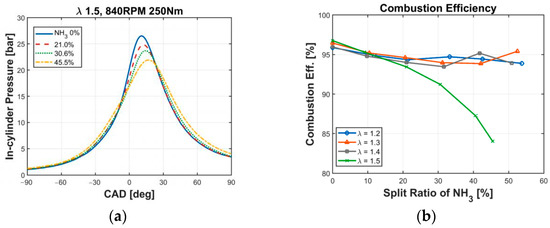
Figure 3.
Effect of ammonia volume fraction. (a) on the maximum pressure in the cylinder; (b) on comustion efficiency in different excess air coefficients.
As shown in Figure 4, with the increase of ammonia-blending ratio, the CO2 emission of mixed combustion gas will be gradually reduced, usually by 18–28%, and the best reduction of CO2 emission (28%) is achieved when the ammonia-blending ratio is 50%, which indicates that ammonia blending can greatly improve the combustion emission of conventional natural gas fuel; however, as shown in Figure 4, NOx emissions increase significantly with increasing ammonia-blending ratio and reach saturation at 40% of ammonia-blending ratio; in addition, ammonia escapes during combustion because some ammonia has incomplete combustion [42].
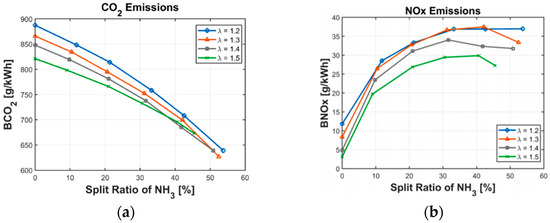
Figure 4.
Effect of volume fraction of ammonia and air coefficient. (a) on CO2 emissions; (b) on NOx emissions.
4.1.3. Gasoline
Ryu K et al. found experimentally, as in Figure 5, that the ammonia injection time can greatly affect the power of the ammonia-blended gasoline engine, with the output of the ammonia-blended gasoline fueled engine reaching 1.5–2.7 kW when the engine is at a baseline power of 0.6 kW, but the maximum combustion pressure in the cylinder is reduced due to the combustion properties of ammonia. In Figure 6, the ammonia-blended gasoline engine has almost no effect on Brake Specific Energy Consumption (BSEC) compared to the pure gasoline engine.
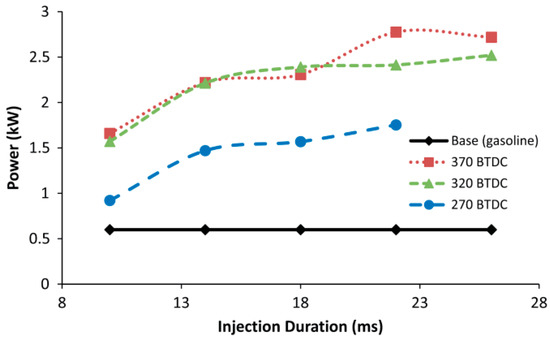
Figure 5.
Effect of ammonia injection delay on engine power.
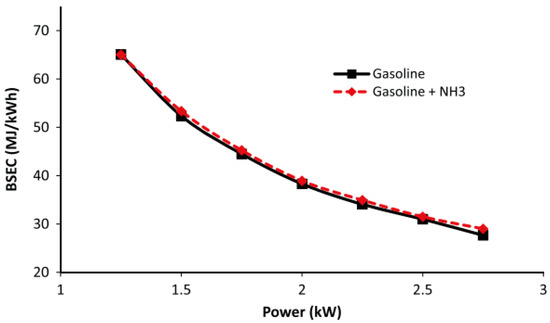
Figure 6.
Comparison of BSEC for single gasoline engine and hybrid engine.
In terms of emissions, as shown in Figure 7, NOx and ammonia emissions in the mixed fuel engine increase sharply with increasing power. It is also noted in the study that as the power increases, the inadequate combustion of ammonia increases and the NOx emissions increase, while ammonia escape becomes more pronounced; As shown in Figure 8, the lower combustion temperature of ammonia also leads to incomplete combustion of blended gasoline, which in turn increases the HC content of the emitted material; additionally, as shown in Figure 8, ammonia-blended hydrogen fuel reduces exhaust gas CO emissions (compared to pure gasoline fueled engines) because ammonia replaces part of the gasoline combustion and accelerates the conversion of CO to CO2 [43].

Figure 7.
NOx and ammonia emissions at different power levels.

Figure 8.
Comparison of emissions at different power levels: (a) HC emissions; (b) CO emissions.
4.2. Compression-Ignition Engine
4.2.1. Diesel
Reiter A. J. et al. modified a direct injection engine with a displacement of 4.5 L and a speed range of 1000~1800 rpm to perform tests on the combustion characteristics as well as emission characteristics of ammonia-blended diesel fuel. It was demonstrated experimentally (Figure 9) that when controlling the diesel flow rate constant, the adjustable engine torque can be achieved by modifying the ammonia flow rate in the specified engine load range (5~80%), and the peak engine torque output can be achieved. Moreover, experiments have demonstrated that ammonia can replace up to 95% of the total energy and that the engine has the best SFC (Specific Fuel Consumption) when the energy provided by ammonia is in the range of 40% to 80% of the total energy.
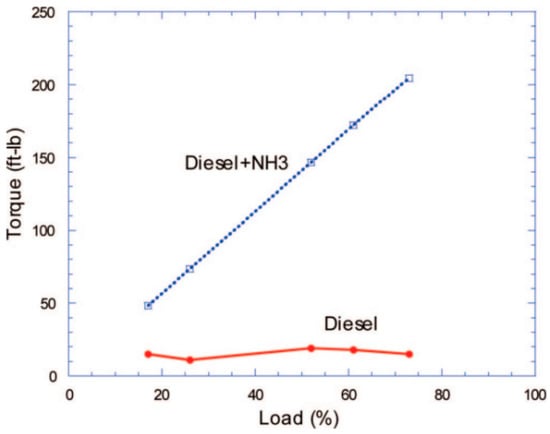
Figure 9.
Torque conditions at different loads and fixed diesel injection volumes.
As for the emission, as shown in Figure 10, with the increase of ammonia-blending ratio, the incomplete combustion of diesel fuel increases, the combustion temperature of mixed combustibles decreases, and the HC emission increases first, and then decreases gradually due to the further increase of the ammonia-blending ratio; the total amount of carbon containing substances decreases, as shown in Figure 10; the CO2 emission decreases monotonically with the increase of ammonia-blending ratio. As shown in Figure 10, at peak torque and 1000 rpm of the hybrid engine, when the ammonia doping is relatively low, the NOx emission is obviously lower than the ammonia emission of the conventional diesel engine, but when the ammonia doping ratio is greater than 60%, the NOx emission will rise sharply, but as long as it does not exceed 70%, the NOx emission of the hybrid engine is still lower than the NOx emission level of the diesel engine [44,45].

Figure 10.
Effect of different ammonia doping ratios on emissions: (a) HC emissions; (b) CO2 emissions; (c) NOx emissions.
4.2.2. DME
Gross C. W. et al. modified a 320 cm3 displacement engine with a 20:1 compression ratio to ensure stable combustion and performing emission tests of ammonia-blended DME. As shown in Figure 11, the combustion experiments of blended fuels were conducted after sufficient preheating with moderate load and moderate speed to ensure the experiments were reasonable.
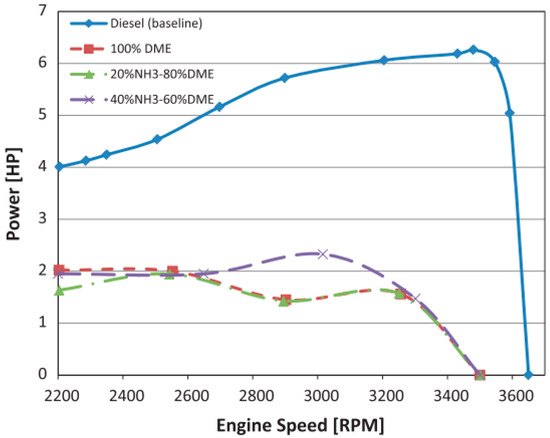
Figure 11.
Range of different test conditions.
It was found that the lower flame speed and higher auto-ignition temperature of ammonia leads to a longer ignition delay and also limits the load conditions of the engine; however, when the injection pressure was increased from the normal injection pressure of DME (150 bar) to 180 bar, the combustion of the fuel mixture was improved.
As shown in Figure 12, in terms of emissions, ammonia-blended DME results in significantly higher NOx emissions compared to pure DME, especially when the engine is running at 15 g/kWh (Mode 7 and Mode 21 in Figure 12); the NOx emissions from the blended fuel are nearly twice as high as the NOx emissions from pure DME combustion; while NOx emissions improve when the ammonia-blending ratio reaches 40%, the injection pressure needs to be increased to achieve proper combustion of the blended fuel at this blending ratio. In addition, ammonia-blended DME engines will have a significant increase in ammonia escape as the engine load increases [46].
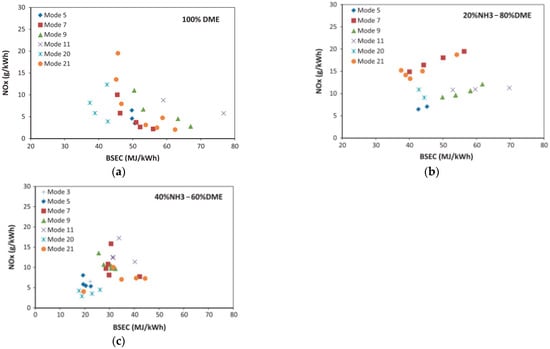
Figure 12.
NOx emissions at different ammonia doping ratios; (a) 100% DME; (b) 20% NH3–80% DME; (c) 40% NH3–60% DME.
4.3. Comparison Analysis
In summary, a comparison of the effects of combustion effectiveness and emission characteristics of various fuel blends before and after the addition of different proportions of ammonia is represented in Table 2 and Figure 13.

Table 2.
Comparison of the combustion characteristics of different fuels after mixing with ammonia. (Compared with the engines using pure fuel in the “Type” column.)
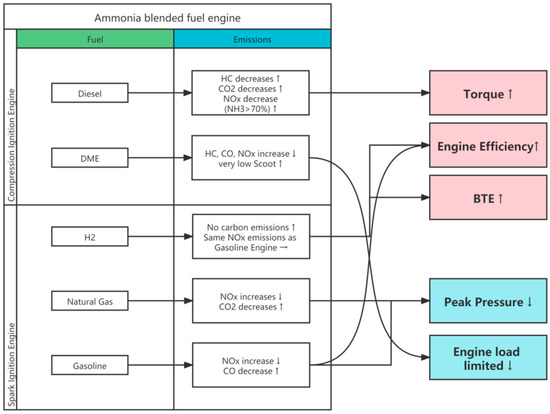
Figure 13.
Summary of the effects of different blended fuels.
From the above and Table 2, it can be seen that, as of the current study, ammonia can be improved to some extent in combustion performance after using other fuels for combustion boosters for blending. As the proportion of ammonia increases, the emissions of carbonaceous substances (HC, CO, and CO2) decrease to some extent (except for DME, where the emissions of HC, CO, and NOx increase with the increase of ammonia compared to the emissions of pure DME fuel engines), but the corresponding NOx emissions also increase.
Among the different fuel blends of ammonia, hydrogen has some positive benefits, which are as follows:
- The blending of ammonia with hydrogen can improve the combustion properties of ammonia with less negative impact compared to other blended fuels;
- Both ammonia and hydrogen have a higher octane number and can try to burn at a higher compression ratio, thus improving the engine cycle thermal efficiency and output power;
- Theoretically no additional carbon-containing substances are emitted from the emission;
- The main pollutant in the emissions of blended fuels is NOx, which is emitted at levels similar to those emitted by fossil fuel combustion and can be effectively cleaned by SCR technology or the ternary catalysts now widely used.
5. Problems and Solutions of Ammonia-Blended Hydrogen Engine
5.1. Problems
As shown in Figure 14, the fuel supply system in ammonia-blended hydrogen engines is complex and the hydrogen for blending requires a separate space and a separate container for storage.
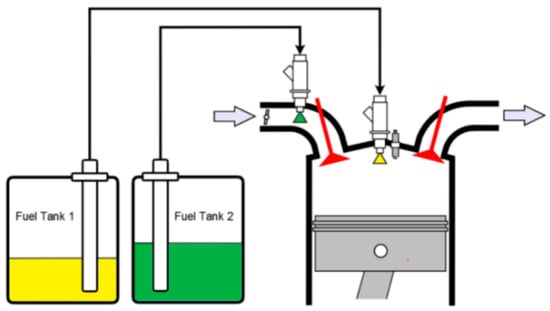
Figure 14.
Schematic diagram of fuel supply system for ammonia-blended hydrogen hybrid fuel engine.
As shown in Figure 15, the ammonia-blended fuel has better combustion thermal efficiency compared to pure gasoline fuel, and different blending ratios influence the combustion thermal efficiency, and usually the ammonia-blended hydrogen fuel engine has the best efficiency and output power at 10% volume fraction of hydrogen-blending ratio [47].
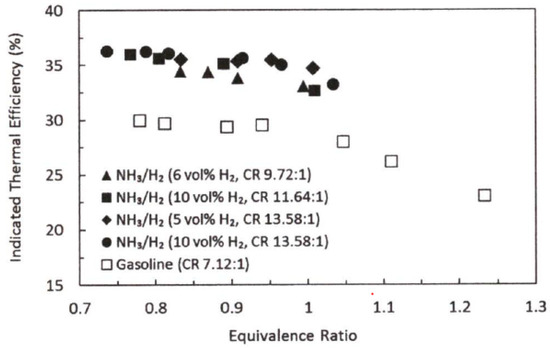
Figure 15.
Thermal efficiency at different compression ratios and hydrogen-doping ratios.
Therefore, for ammonia-blended hydrogen engines, the amount of hydrogen used for combustion is relatively small. As shown in Figure 16, although the use of ammonia decomposition to produce hydrogen raises some of the costs, the use of ammonia as a hydrogen energy carrier to store and transport hydrogen has a significant economic cost advantage when considering the production, transportation, and storage [48].
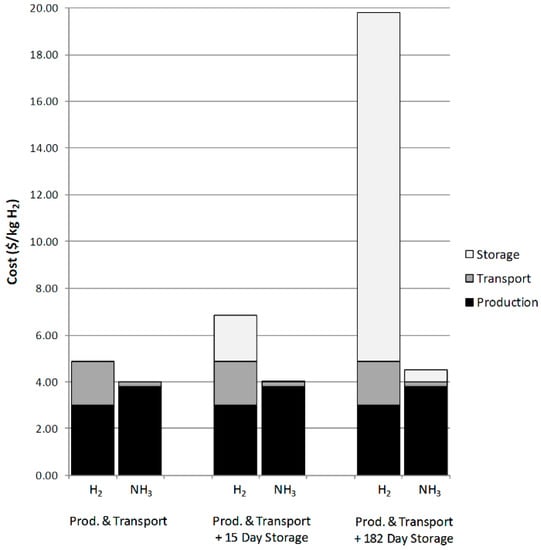
Figure 16.
Comparison of production, transportation, and storage costs of hydrogen and ammonia.
5.2. Hydrogen Production Methods
In the field of research, many researchers have been strengthening the research of the “green hydrogen” manufacturing process in order to respond to the carbon reduction and “carbon neutral” policies, to reduce the proportion of fossil fuels in the hydrogen production industry, and to eliminate the pollution of society and the environment caused by the use of fossil fuels. At present, the mainstream “green hydrogen” manufacturing methods include electrolysis of water [9,49,50,51,52,53,54,55,56,57,58], biomass hydrogen [59,60,61,62], solar hydrogen [63,64,65,66,67,68,69,70,71,72], and ammonia decomposition hydrogen [73,74].
Among those, for ammonia-blended hydrogen engines, the use of ammonia decomposition to produce hydrogen is beneficial. As one of the fuels in a blended engine, ammonia can be used directly for the production of hydrogen, and it can be achieved without major changes to the overall structure of the engine.
5.3. Ammonia Decomposition
Ammonia is a fuel with high hydrogen density (17.6% hydrogen mass fraction, compared to 12.5% hydrogen mass fraction in methanol) [75,76,77], and its catalytic decomposition products are free from pollutants, making it an ideal source of hydrogen. Currently, the main ammonia decomposition pathways are multiphase catalysis, photocatalysis, ammonia electrolysis, high-temperature pyrolysis, and plasma methods. While the purpose of the research on multiphase catalysis is mainly hydrogen production, other studies are aimed at understanding the mechanism of ammonia synthesis or ammonia decomposition. Therefore, in the following, we focus on the hydrogen production methods related to multiphase catalysis.
Ammonia is a thermodynamically unstable substance at high temperatures and will start to decompose at 200 °C. The equilibrium conversion of ammonia can reach 99.75% at 500 °C [78].
In the field of plasma decomposition of ammonia to produce hydrogen, the method of sliding arc discharge plasma decomposition of ammonia to produce hydrogen is currently studied by Li Xiaodong’s group. It is found that this method can achieve hydrogen production by decomposing ammonia through high-energy electrons and various reactive groups generated in the discharge point process without catalyst and at room temperature and pressure, but its ammonia conversion rate is influenced by the discharge power of the plasma, and the efficiency is usually lower than that of the multiphase catalytic method [79].
It was found that the coupling of dielectric barrier discharge plasma (DBD) and non-precious metal catalysts for ammonia decomposition in hydrogen production has significant synergistic effects. Among them, the plasma can promote both reactant adsorption activation and product desorption on the catalyst surface, and can greatly increase the conversion rate of ammonia decomposition [80].
Sun Shuaiqi et al. experimentally concluded that under the conditions of ammonia flow rate of 120 mL/min, reaction air velocity of 14,400 h−1 and reaction temperature of 550 °C, the ammonia decomposition conversions corresponding to thermal catalysis, plasma, and plasma catalysis were 28%, 22%, and 98%, respectively, i.e., the conversion effect of plasma catalysis was significant (see Figure 17) [81].
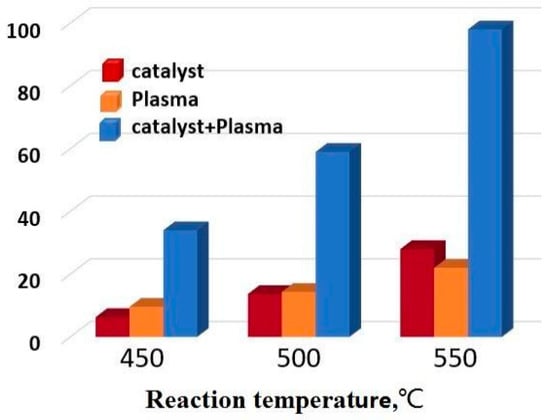
Figure 17.
Comparison of the efficiency of three methods of hydrogen production by ammonia decomposition at different temperatures.
Stefano Frigo et al. installed an ammonia catalytic reformer on an engine to use the heat of the engine exhaust gas to produce hydrogen by ammonia decomposition and then mixed combustion with it, which proved for the first time the feasibility of an engine for hydrogen by ammonia decomposition and mixed combustion with ammonia. However, the aim of this study was to use it only as a booster generator for an electric vehicle, not as a main internal combustion engine [82,83]. Kyunghyun Ryu et al. conducted a similar ammonia-catalyzed reforming hydrogen production test on a CFR (cooperative fuels research) engine, which proposed that an additional heat tape could be provided to provide sufficient heat for ammonia decomposition [84].
5.4. Summary
For ammonia-doped hydrogen engines, a doping ratio of 10% is usually taken for the best combustion and operating efficiency [38]. For this reason, a large volume of hydrogen storage alone would lead to a large waste of energy and space resources and increase many safety hazards. Thus, the use of hydrogen production to supply the hydrogen source can minimize the waste of resources, reduce the safety hazards, and ensure the effective operation of ammonia-blended hydrogen engines. Today, hydrogen production by ammonia decomposition is more intensively researched and requires less equipment, and hydrogen production can be effectively carried out in larger cars or ships, and ammonia is also a fuel for blending engines without additional storage. Ammonia is also a fuel for doped engines and does not require additional storage.
In the above-mentioned studies, ammonia decomposition hydrogen production was shown to be a viable means of hydrogen production for direct hydrogen production instead of hydrogen storage, which could reduce some overall costs and some equipment used for hydrogen storage. However, there are still many problems with this method. For example, as the ammonia flow rate and consumption increases, the short residence time of ammonia in the catalyst leads to a decrease in hydrogen production, making the volume ratio of ammonia to hydrogen not optimal.
In summary, the method still needs more experimental investigations on the engine, such as strengthening the catalytic efficiency and adding temperature control modules to achieve continuous, stable, and sufficient hydrogen production.
6. Discussion
- This paper firstly introduces the physicochemical properties of ammonia fuel, its high calorific value, high octane number, good combustion efficiency, pure combustion products, low cost, easy transportation, etc., which can support ammonia as an excellent fuel; ammonia fuel also has many disadvantages, such as toxicity and corrosiveness, low calorific value, high ignition point, low minimum ignition energy, etc., which limit the development of ammonia as a fuel;
- The paper then reviews the feasible and adopted solutions proposed by some researchers for the drawbacks of ammonia fuel; based on the special physicochemical properties of ammonia, the paper then introduces the early and recent research on pure ammonia-fueled engines, explaining that there are still many research limitations in the development of pure ammonia-fueled engines, and emphasizing the need for research on ammonia-blended engines;
- Then, this paper compares and analyzes different ammonia-blended engines in terms of their combustion performance and combustion emission products. Among them, ammonia blended with hydrogen is considered as a more ideal blending scheme, although further research and experimental verification are still needed;
- Finally, for hydrogen storage, the feasibility of hydrogen production is explored in this paper. Some of the research on ammonia decomposition for hydrogen production is highlighted. This method can reduce the comprehensive cost and avoid the space problem and safety problem caused by hydrogen storage. However, the current research in this area is mainly at the stage of experimental analysis, which will be affected by factors such as ammonia flow rate and catalytic temperature in the process of practical application, and further structural and performance optimization is needed to obtain a more stable and sufficient supply of hydrogen source.
While the ammonia-doped hydrogen fuel engine is still in the research and development stage, with further research and development of ammonia-blended hydrogen engine and ammonia decomposition hydrogen production technology, ammonia fuel will gradually be widely developed and applied as a new, clean, renewable, and reliable alternative fuel in the future, improving the current carbon emission problem and promoting the development of the energy industry.
Author Contributions
Data curation, F.L.; review and suggestions, X.X. and F.Q.; writing-review and editing, N.Z. and E.L. All authors have read and agreed to the published version of the manuscript.
Funding
This research was funded by the National Natural Science Foundation of China under Grant 51975426, the Wuhan Science and Technology Project under Grant 2019010701011393, the open fund of Hubei Key Laboratory of Mechanical Transmission and Manufacturing Engineering at Wuhan University of Science and Technology under Grant 2017A12.
Institutional Review Board Statement
Not applicable.
Informed Consent Statement
Not applicable.
Data Availability Statement
Not applicable.
Acknowledgments
The authors thank all of the authors of the references cited in this article, the National Natural Science Foundation of China, and the Wuhan Science and Technology Project for supporting this work.
Conflicts of Interest
The authors declare no conflict of interest.
References
- Zemin, J. Reflections on energy issues in China. J. Shanghai Jiaotong Univ. 2008, 42, 345–359. [Google Scholar] [CrossRef]
- Zou, C.; Xiong, B.; Huaqing, X.; Zheng, D. The role of new energy in carbon neutral. Pet. Explor. Dev. 2021, 48, 411–420. [Google Scholar] [CrossRef]
- IPPC. Global Warming of 1.5 °C. Available online: https://www.ipcc.ch/sr15 (accessed on 24 September 2021).
- IEA. Global CO2 Emissions in 2019. Available online: https://www.iea.org/articles/global-co2-emissions-in-2019 (accessed on 24 September 2021).
- IEA. CO2 Emissions from Fuel Combustion Highlights. Available online: https://www.iea.org/data-and-statistics/data-product/co2-emissions-from-fuel-combustion-highlights#highlights (accessed on 24 September 2021).
- Sonachalam, M.; Paulpandian, P.; Manieniyan, V. Emission reduction in diesel engine with acetylene gas and biodiesel using inlet manifold injection. Clean Technol. Environ. Policy 2020, 22, 2177–2191. [Google Scholar]
- Sonachalam, M.; Manieniyan, V. Impact of secondary fuel injector in various distance on direct injection diesel engine using acetylene-bio diesel in reactivity controlled compression ignition mode. Energy Sources Part A Recovery Util. Environ. Eff. 2020, 22, 2177–2191. [Google Scholar] [CrossRef]
- Yue, M.; Lambert, H.; Pahon, E.; Roche, R.; Jemei, S.; Hissel, D. Hydrogen energy systems: A critical review of technologies, applications, trends and challenges–ScienceDirect. Renew. Sustain. Energy Rev. 2021, 146, 111180. [Google Scholar] [CrossRef]
- Su, H.; Linkou, V.; Bladergroen, B.J. Membrane electrode assemblies with low noble metal loadings for hydrogen production from solid polymer electrolyte water electrolysis. Int. J. Hydrog. Energy 2013, 38, 9601–9608. [Google Scholar] [CrossRef] [Green Version]
- Yang, Z. Hydrogen Fuel Engine Combustion and Optimal Control; Zhejiang University: Zhejiang, China, 2001. [Google Scholar]
- Yang, Z.; Wang, L.; Wei, L. Prospect and Development on Hydrogen fueled Engines. In Proceedings of the China International Hydrogen Energy Conference, Shanghai, China, September 2007; China Industrial Gases Industry Association: Beijing, China, 2007. [Google Scholar]
- Agustin, V.-M.; Rene, B.-A. Ammonia Production Technologies—ScienceDirect. In Techno-Economic Challenges of Green Ammonia as an Energy Vector; Elsevier: Amsterdam, The Netherlands, 2021; pp. 41–83. [Google Scholar]
- Valera-Medina, A.; Xiao, H.; Owen-Jones, M.; David, W.I.; Bowen, P.J. Ammonia for power. Prog. Energy Combust. Sci. 2018, 69, 63–102. [Google Scholar] [CrossRef]
- Jianquan, H.; Shan, X.; Yichun, W.; Jianxiang, Z.; Wenzhong, M. Study on low carbon ammonia engine. Renew. Energy Resour. 2014, 32, 1505–1509. [Google Scholar]
- Danan, C.; Jun, L.; Hongyu, H.; Ying, C.; Zhaohong, H.; Lisheng, D. Progress in Ammonia Combustion and Reaction Mechanism. Chemistry 2020, 6, 508–515. [Google Scholar]
- The Royal Society. Ammonia: Fuel and Energy Store; The Royal Society: London, UK, 2020. [Google Scholar]
- MacFarlane, D.R.; Cherepanov, P.V.; Choi, J.; Suryanto, B.H.; Hodgetts, R.Y.; Bakker, J.M.; Vallana, F.M.F.; Simonov, A.N. A Roadmap to the Ammonia Economy. Joule 2020, 4, 1186–1205. [Google Scholar] [CrossRef]
- Lloyd’s Register. Decarbonising Shipping-Could Ammonia Be the Fuel of the Future; Lloyd’s Register: London, UK, 2021. [Google Scholar]
- Ma, J.; Liu, X.D.; Chen, Y.S. Current Status and Countermeasures for China’s New Energy Automobile Industry and Technology Development. China J. Highw. Transp. 2018, 31, 1–19. [Google Scholar] [CrossRef]
- Pengyan, G.; Fang, S.; Lijun, W.; Fangge, S.; Peng, Z. Research Status and Development Trend for Ammonia-fueled Engines. Veh. Engine 2016, 1–5, 13. [Google Scholar] [CrossRef]
- Zacharakisjutz, G.E. Performance Characteristics of Ammonia Engines Using Direct Injection Strategies. Ph.D. Thesis, Iowa State University, Ames, IA, USA, 2013. [Google Scholar]
- Liu, R.; Ting, D.S.K.; Checkel, M.D. Ammonia as a Fuel for SI Engine; SAE Technical Paper; SAE: Warrendale, PA, USA, 2003. [Google Scholar]
- Zeng, S.J.; Shang, D.W.; Yu, M.; Chen, H.; Dong, H.; Zhang, X. Applications and perspectives of NH3 separation and recovery with ionic liquids. CIESC J. 2019, 70, 10. [Google Scholar]
- Xu, X.; Xu, Q.; Huang, G.; Wang, L.; Huang, L. Removal of ammonia by absorption combined with electrochemical oxidation on RuO2/Ti anode. CIESC J. 2016, 67, 7. [Google Scholar]
- Giddey, S.; Badwal, S.; Kulkarni, A. Review of electrochemical ammonia production technologies and materials. Int. J. Hydrog. Energy 2013, 38, 14576–14594. [Google Scholar] [CrossRef]
- Jha, P.; Ramgir, N.S.; Sharma, P.K.; Datta, N.; Kailasaganapathi, S.; Kaur, M.; Koiry, S.P.; Saxena, V.; Chauhan, A.K.; Debnath, A.K.; et al. Charge transport and ammonia sensing properties of flexible polypyrrole nanosheets grown at air–liquid interface. Mater. Chem. Phys. 2013, 140, 300–306. [Google Scholar] [CrossRef]
- Feng, X. Methanol-Ammonia and the New Energy Economy; Chemical Industry Press: Beijing, China, 2010; pp. 60–62. Available online: https://baike.baidu.com/item/%E7%94%B2%E9%86%87%C2%B7%E6%B0%A8%E5%92%8C%E6%96%B0%E8%83%BD%E6%BA%90%E7%BB%8F%E6%B5%8E/3274627?fr=aladdin (accessed on 20 January 2022).
- Reiter, A.J.; Kong, S.C. Combustion and emissions characteristics of compression-ignition engine using dual ammonia-diesel fuel. Fuel 2011, 90, 87–97. [Google Scholar] [CrossRef] [Green Version]
- Toyota Motor Corporation. Exhaust Cleaning Device for Engines. CN200980159001.8. 11 April 2004. Available online: https://wenku.baidu.com/view/a0ce8cf769d97f192279168884868762cbaebbe5?fr=xueshu (accessed on 20 January 2020).
- Newhall, H.K.; Starkman, E.S. Theoretical Performance of Ammonia as a Gas Turbine Fuel; SAE Technical Paper; SAE International: Warrendale, PA, USA, 1966. [Google Scholar]
- Thurston, R.H. A History of the Growth of the Steam-Engine. Nature 1972, 19, 381–382. [Google Scholar]
- Grimes, P.G. Energy Depot Fuel Production and Utilization. In Proceedings of the International Automotive Engineering Congress & Exposition. 1965. Available online: https://www.researchgate.net/publication/296647846_Energy_Depot_Fuel_Production_and_Utilization (accessed on 20 January 2022).
- Gray, J.T., Jr.; Dimitroff, E.; Meckel, N.T.; Quillian, R.D., Jr. Ammonia Fuel-Engine Compatibility and Combustion. In Proceedings of the Automotive Engineering Congress & Exposition. 1966. Available online: https://www.researchgate.net/publication/296646977_Ammonia_Fuel_-_Engine_Compatibility_and_Combustion (accessed on 20 January 2022).
- Pearsall, T.J.; Garabedian, C.G. Combustion of Anhydrous Ammonia in Diesel Engines; SAE Technical Paper 670947; SAE International: Warrendale, PA, USA, 1967. [Google Scholar]
- Pearsall, T.J. Ammonia Application to Reciprocating Engines. Volume 1. 1967. Available online: https://www.researchgate.net/publication/235199347_AMMONIA_APPLICATION_TO_RECIPROCATING_ENGINES_VOLUME_1 (accessed on 20 January 2022).
- Li, J.; Huang, H.; Kobayashi, N.; He, Z.; Osaka, Y.; Zeng, T. Numerical study on effect of oxygen content in combustion air on ammonia combustion. Energy 2015, 93, 2053–2068. [Google Scholar] [CrossRef]
- Duynslaegher, C.; Jeanmart, H.; Vandooren, J. Ammonia Combustion in spark ignition engine conditions. In Proceedings of the 7th Annual NH3 Fuel Conference, Romulus, MI, USA, 26–28 September 2010. [Google Scholar]
- Mørch, C.S.; Bjerre, A.; Gøttrup, M.P.; Sorenson, S.C.; Schramm, J. Ammonia/hydrogen mixtures in an Si-engine: Engine performance and analysis of a proposed fuel system. Fuel 2011, 90, 854–864. [Google Scholar] [CrossRef]
- Westlye, F.R.; Ivarsson, A.; Schramm, J. Experimental investigation of nitrogen based emissions from an ammonia fueled SI-engine. Fuel 2013, 111, 239–247. [Google Scholar] [CrossRef]
- Lee, J.H.; Kim, J.H.; Park, J.H.; Kwon, O.C. Studies on properties of laminar premixed hydrogen-added ammonia/air flames for hydrogen production. Int. J. Hydrog. Energy 2010, 35, 1054–1064. [Google Scholar] [CrossRef]
- Kumar, P.; Meyer, T.R. Experimental and modeling study of chemical-kinetics mechanisms for H2–NH3–air mixtures in laminar premixed jet flames. Fuel 2013, 108, 166–176. [Google Scholar] [CrossRef]
- Oh, S.; Park, C.; Kim, S.; Kim, Y.; Choi, Y.; Kim, C. Natural gas–ammonia dual-fuel combustion in spark-ignited engine with various air–fuel ratios and split ratios of ammonia under part load condition. Fuel 2021, 290, 120095. [Google Scholar] [CrossRef]
- Ryu, K.; Zacharakis-Jutz, G.E.; Kong, S.C. Effects of gaseous ammonia direct injection on performance characteristics of a spark-ignition engine. Appl. Energy 2014, 116, 206–215. [Google Scholar] [CrossRef]
- Reiter, A.J.; Kong, S.C. Demonstration of Compression-Ignition Engine Combustion Using Ammonia in Reducing Greenhouse Gas Emissions. Energy Fuels 2008, 22, 2963–2971. [Google Scholar] [CrossRef]
- Reiter, A.J.; Kong, S.C. Diesel Engine Operation Using Ammonia as a Carbon-Free Fuel. In Proceedings of the Internal Combustion Engine Division Fall Technical Conference, Online, 4–6 November 2010; Volume 49446, pp. 111–117. [Google Scholar]
- Gross, C.W.; Kong, S.C. Performance characteristics of a compression-ignition engine using direct-injection ammonia–DME mixtures. Fuel 2013, 103, 1069–1079. [Google Scholar] [CrossRef]
- Lesmana, H.; Zhang, Z.; Li, X.; Zhu, M.; Xu, W.; Zhang, D. NH3 as a Transport Fuel in Internal Combustion Engines: A Technical Review. J. Energy Resour. Technol. 2019, 141, 070703. [Google Scholar] [CrossRef]
- Bartels, J.R. A Feasibility Study of Implementing an Ammonia Economy; Iowa State University: Ames, IA, USA, 2008. [Google Scholar]
- Yeh, T.F.; Syu, J.M.; Cheng, C.; Chang, T.H.; Teng, H. Graphite Oxide as a Photocatalyst for Hydrogen Production from Water. Adv. Funct. Mater. 2010, 20, 2255–2262. [Google Scholar] [CrossRef]
- Maeda, K.; Teramura, K.; Lu, D.; Takata, T.; Saito, N.; Inoue, Y.; Domen, K. Photocatalyst releasing hydrogen from water. Nature 2006, 440, 295. [Google Scholar] [CrossRef]
- Li, Y.; Chen, J.; Liu, C.; Yang, Y.; Li, F.; Gong, Y.; Liu, M. Progress in Hydrogen Preparation Technology. Plat. Finish. 2019, 41, 6. Available online: https://wenku.baidu.com/view/fcc477617ed184254b35eefdc8d376eeafaa1713?fr=xueshu (accessed on 20 January 2022).
- Gahleitner, G. Hydrogen from renewable electricity: An international review of power-to-gas pilot plants for stationary applications. Int. J. Hydrog. Energy 2013, 38, 2039–2061. [Google Scholar] [CrossRef]
- Laube, A.; Hofer, A.; Ressel, S.; Chica, A.; Bachmann, J.; Struckmann, T. PEM water electrolysis cells with catalyst coating by atomic layer deposition. Int. J. Hydrog. Energy 2021, 46, 38972–38982. [Google Scholar] [CrossRef]
- Ayers, K. High efficiency PEM water electrolysis: Enabled by advanced catalysts, membranes, and processes. Curr. Opin. Chem. Eng. 2021, 33, 100719. [Google Scholar] [CrossRef]
- Brisse, A.; Schefold, J.; Zahid, M. High temperature water electrolysis in solid oxide cells. Int. J. Hydrog. Energy 2008, 33, 5375–5382. [Google Scholar] [CrossRef]
- Laguna-Bercero, M.A. Recent advances in high temperature electrolysis using solid oxide fuel cells: A review. J. Power Sources 2012, 203, 4–16. [Google Scholar] [CrossRef] [Green Version]
- Gao, M.; Sheng, W.; Zhuang, Z.; Fang, Q.; Gu, S.; Jiang, J.; Yan, Y. Efficient water oxidation using nanostructured α-nickel-hydroxide as an electrocatalyst. J. Am. Chem. Soc. 2014, 136, 7077–7784. [Google Scholar] [CrossRef]
- Chi, J.; Yu, H. Water electrolysis based on renewable energy for hydrogen production. Chin. J. Catal. 2018, 39, 390–394. [Google Scholar] [CrossRef]
- Song, T.; Wu, J.; Shen, L.; Xiao, J. Experimental investigation on hydrogen production from biomass gasification in interconnected fluidized beds. Biomass Bioenergy 2012, 36, 258–267. [Google Scholar] [CrossRef]
- Levin, D.B.; Chahine, R. Challenges for renewable hydrogen production from biomass—ScienceDirect. Int. J. Hydrog. Energy 2010, 35, 4962–4969. [Google Scholar] [CrossRef]
- Mishra, P.; Krishnan, S.; Rana, S.; Singh, L.; Sakinah, M.; Ab Wahid, Z. Outlook of fermentative hydrogen production techniques: An overview of dark, photo and integrated dark-photo fermentative approach to biomass. Energy Strategy Rev. 2019, 24, 27–37. [Google Scholar] [CrossRef]
- Wang, D.; He, C.; Jiang, W. Research of industrial hydrogen production at home and abroad. Ind. Catal. 2018, 26, 26–30. [Google Scholar] [CrossRef]
- Roel, V.; Liang, Y.; Schoonman, J. Solar hydrogen production with nanostructured metal oxides. J. Mater. Chem. 2008, 18, 2311. [Google Scholar]
- Joshi, A.S.; Dincer, I.; Reddy, B.V. Solar hydrogen production: A comparative performance assessment. Int. J. Hydrog. Energy 2011, 36, 11246–11257. [Google Scholar] [CrossRef]
- Wu, H. Research Progress in Several Methods of Hydrogen Producing Technology. Guangdong Chem. Ind. 2013, 40, 111–112. [Google Scholar] [CrossRef]
- Kogan, A. Direct solar thermal splitting of water and on site separation of the products I. Theoretical evaluation of hydrogen yield. Int. J. Hydrog. Energy 1997, 22, 481–486. [Google Scholar] [CrossRef]
- Kogan, A. Direct solar thermal on-site separation of the products-II. experimental feasibility study. Int. J. Hydrog. Energy 1998, 23, 89–98. [Google Scholar] [CrossRef]
- Kogan, A. Direct solar thermal splitting of water and on-site separation of the products. III. Improvement of reactor efficiency by steam entrainment. Int. J. Hydrog. Energy 1998, 25, 739–745. [Google Scholar] [CrossRef]
- Kogan, A. Direct solar thermal splitting of water and on-site separation of the products-IV. Development of porous ceramic membranes for a solar thermal water-splitting reactor. Int. J. Hydrog. Energy 2000, 25, 1043–1050. [Google Scholar] [CrossRef]
- Fujishima, A.; Honda, K. Electrochemical Photolysis of Water at a Semiconductor Electrode. Nature 1972, 238, 37–38. [Google Scholar] [CrossRef]
- Wang, J.; Zhao, Y.F.; Wang, T.; Li, H.; Li, C. Photonic, and photocatalytic behavior of TiO2 mediated by Fe, CO, Ni, N doping and co-doping. Phys. B Condens. Matter 2015, 478, 6–11. [Google Scholar] [CrossRef]
- Hwang, K.S.; Kim, S.D.; Hwangbo, S.; Kim, J.T. Effect of Metal (Ni2+, Fe3+, and Mo3+) Doping in TiO2 Thin Films on Antimicrobial Activity. J. Nanoelectron. Optoelectron. 2017, 12, 413–417. [Google Scholar] [CrossRef]
- Thomas, G.; Parks, G. Potential Roles of Ammonia in a Hydrogen Economy. 2006. Available online: https://www.researchgate.net/publication/331595915_Potential_Roles_of_Ammonia_in_a_Hydrogen_Economy (accessed on 20 January 2022).
- Li, Y.; Yao, L.; Song, Y.; Liu, S.; Zhao, J.; Ji, W.; Au, C.T. Core–shell structured microcapsular-like Ru@SiO2reactor for efficient generation of COx-free hydrogen through ammonia decomposition Electronic supplementary information (ESI) available: N2adsorption–desorption data, H2-TPD and H2-TPR. Chem. Commun. 2010, 46, 5298–5300. [Google Scholar] [CrossRef] [PubMed]
- Avery, W.H. A role for ammonia in the hydrogen economy. Int. J. Hydrog. Energy 1988, 13, 761–773. [Google Scholar] [CrossRef]
- Lan, R.; Irvine, J.T.; Tao, S. Ammonia and related chemicals as potential indirect hydrogen storage materials. Int. J. Hydrog. Energy 2012, 37, 1482–1494. [Google Scholar] [CrossRef]
- Christensen, C.H.; Johannessen, T.; Sørensen, R.Z.; Nørskov, J.K. Towards an ammonia-mediated hydrogen economy? Catal. Today 2006, 111, 140–144. [Google Scholar] [CrossRef]
- Zhu, C. Study of Nickel-Based Low-Temperature Ammonia Decomposition Catalysts and Their Carriers; Tianjin University: Tianjin, China, 2007. [Google Scholar] [CrossRef]
- Yan, S.; Li, X.; Zhong, L. Gliding Arc Discharge Plasma Assisted Decomposition of Ammonia into Hydrogen. J. Combust. Sci. Technol. 2011, 17, 186–190. [Google Scholar]
- Wang, L. Study on the Synergistic Effect of Plasma-Catalyzed Ammonia Decomposition for Hydrogen Production; University of Technology: Dalian, China, 2013. [Google Scholar]
- Sun, S. Loaded Bimetallic Catalyst for Hydrogen Production by Ammonia Decomposition; Dalian University of Technology: Dalian, China, 2017. [Google Scholar]
- Frigo, S.; Gentili, R. Analysis of the behaviour of a 4-stroke Si engine fuelled with ammonia and hydrogen. Int. J. Hydrog. Energy 2013, 38, 1607–1615. [Google Scholar] [CrossRef]
- Comotti, M.; Frigo, S. Hydrogen generation system for ammonia–hydrogen fuelled internal combustion engines. Int. J. Hydrog. Energy 2015, 40, 10673–10686. [Google Scholar] [CrossRef]
- Ryu, K.; Zacharakis-Jutz, G.E.; Kong, S.C. Performance enhancement of ammonia-fueled engine by using dissociation catalyst for hydrogen generation. Int. J. Hydrog. Energy 2014, 39, 2390–2398. [Google Scholar] [CrossRef]
Publisher’s Note: MDPI stays neutral with regard to jurisdictional claims in published maps and institutional affiliations. |
© 2022 by the authors. Licensee MDPI, Basel, Switzerland. This article is an open access article distributed under the terms and conditions of the Creative Commons Attribution (CC BY) license (https://creativecommons.org/licenses/by/4.0/).